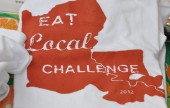New Orleans spoils us for a lot of things, from live jazz to a decent cup of coffee. But perhaps nothing falls shorter in comparison out in the Great Elsewhere than dining.
 We know what good food is, whether it’s five-star fusion or corner-diner dive. And none of us had to be taught that Louisiana strawberries are far sweeter than the California version, or Creole tomatoes juicier than their Mexican counterparts.
We know what good food is, whether it’s five-star fusion or corner-diner dive. And none of us had to be taught that Louisiana strawberries are far sweeter than the California version, or Creole tomatoes juicier than their Mexican counterparts.
So it was with a bit of bemusement that I stumbled across the locavore movement a few years back. It seems others were discovering the pleasures of eating foods produced locally.
As a child growing up in DeRidder, La., in the 1960s, being a locavore was inherent in the lifestyle. In summer we ate Sugartown watermelons and Ruston peaches and picked fresh figs from backyard trees. In winter, we savored Plaquemines oranges and homemade pumpkin pie and gathered pecans from … backyard trees.
I don’t know anyone who picks figs or gathers pecans any more. And I couldn’t tell you where the lettuce in my refrigerator bin was grown, or where the cow for last night’s steak was butchered. I do check my crawfish tails for that taboo “Product of China” label.
But the fact is, with mass transit and big-box stores, the tendency to eat foods produced within a one-tank-of-gas range went the way of TV dinners.
Now, NOLA Locavores are bringing back the trend. And they’ve once again issued an Eat Local Challenge for June, asking all of us to spend the next 26 days thinking about where dinner comes from, and how far it traveled to get here.
Locavore (which was the 2007 Oxford Dictionary Word of the Year, by the way), has its roots as much in eco-consciousness as gastronomy. Because most of those foreign strawberries and tomatoes are carted an average 1,300 to 2,000 miles to reach local grocery shelves, they require a lot of energy use for transportation alone.
 It doesn’t take a rocket scientist to realize that food produced nearby idoesn’t use up a lot of gas to get to you, is fresher and therefore probably healthier, and puts money in the local economy.
It doesn’t take a rocket scientist to realize that food produced nearby idoesn’t use up a lot of gas to get to you, is fresher and therefore probably healthier, and puts money in the local economy.
Though the Eat Local Challenge technically started last Friday, it’s not too late to jump on the bandwagon. You’re even allowed to cheat, kind of. There are four levels of commitment:
Ultrastrict: You have to only eat things grown or produced within 200 miles of New Orleans. Imagine yourself a 17th-century Choctaw. And not to worry, wine from Pontchartrain Vineyards and Becnel Wines are allowed, as they grow their own grapes.
Strict (aka, the Bienville Level): You eat local but get three “vices” a week – a non-local food such as chocolate or Roquefort cheese. You can also go off the wagon for three non-local meals a week. So you don’t have to cancel that three-martini lunch.
Lenient (aka the Ignatius J Reilly Level): For beginners, this allows to you have six non-local food and six non-local meals a week. You will at least be reading labels and learning what came from where.
Ultralenient: You think this is a great idea and are totally in but you travel all week and have six kids and how the heck are you gonna really eat only local stuff — so you’ll try to pull off, say, three or four days tops.
 As with all things New Orleans, the challenge carries the potential for socializing and getting out and about, with events planned all month. When else would one be able to attend a talk on Keeping Urban Chickens, planned at 6 p.m. Wednesday at Edible City Gardens, 417 Dakin, Old Jefferson? Every Tuesday from 5 to 7 p.m., Gary Granata will lead a Cooking Out of the Box session at Rosa Keller Library, 4300 S. Broad, converting a box of produce from that week’s Hollygrove Market into a meal. Bread-making, beer brewing, bee keeping, gelato creations — well, the choices go on and on.
As with all things New Orleans, the challenge carries the potential for socializing and getting out and about, with events planned all month. When else would one be able to attend a talk on Keeping Urban Chickens, planned at 6 p.m. Wednesday at Edible City Gardens, 417 Dakin, Old Jefferson? Every Tuesday from 5 to 7 p.m., Gary Granata will lead a Cooking Out of the Box session at Rosa Keller Library, 4300 S. Broad, converting a box of produce from that week’s Hollygrove Market into a meal. Bread-making, beer brewing, bee keeping, gelato creations — well, the choices go on and on.
Local restaurants, markets and companies are in on the act as well, from Rouses and the new New orleans Food Coop to La Divina and Grown Bayou. And that worry about where my cows were butchered? Local Tulane business grads Simone Reggie and Seth Hamstead are taking care of that with Cleaver & Co., a new locally sourced, whole-animal butcher shop that cuts up whole cows, pigs, chickens and ducks from South Louisiana farms.
Last year, 322 people took the first Eat Local Challenge, all pledging to ask their grocers, “Is it local?” NOLA Locavore figures that if each one spent $50 a week on groceries, it put $65,000 into local pockets, from shrimpers to gardeners and grocers.
You can still register for the challenge online at nolalocavore.org; it costs $25, but that includes a t-shirt and tote bag, a 10 percent discount at Hollygrove Market, access to recipes and participation in the first NOLA Local Scavenger Hunt (with a $500 prize).
I’ve signed up. And yes, you can guess which level of challenge I chose. (Even Ultralenients have to grapple with some touch questions — like, does a pickled okra qualify the Bloody Mary as local?)
Luckily, a number of local restaurants are offering local dishes in conjunction with the challenge. If I get tired of Louisiana strawberries and Creole tomatoes, I can head to Irish House for Covey Rise Farms duck confit salad, or to Café Carmo for some Des Allemands catfish.
But what I wouldn’t give for a good Sugartown melon.
Renee Peck is editor of NolaVie.
 NOLAbeings Multimedia artist Claire Bangser created NOLAbeings as a portrait-based story project that marries...
NOLAbeings Multimedia artist Claire Bangser created NOLAbeings as a portrait-based story project that marries...  Voodoo in New Orleans: Reviving history: New Orleans fortune telling This article takes a deep dive into the history of Voodoo in New Orleans, its hybridization with Catholicism, and its present-day place in the city's culture. The author visits fortune-tellers in the French Quarter, using their guidance as a tool for introspection rather than a deterministic predictor of the future. Through her experiences in New Orleans, the author feels a mystical connection to both the past and the future.
Voodoo in New Orleans: Reviving history: New Orleans fortune telling This article takes a deep dive into the history of Voodoo in New Orleans, its hybridization with Catholicism, and its present-day place in the city's culture. The author visits fortune-tellers in the French Quarter, using their guidance as a tool for introspection rather than a deterministic predictor of the future. Through her experiences in New Orleans, the author feels a mystical connection to both the past and the future. 